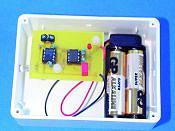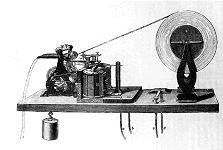
![]() PIC Video
Cleaner
PIC Video
Cleaner
At last! PIC-power comes to your aid to enhance your video PICture quality.
The Macrovision® copy prevention system can sometimes affect the playback
quality of some tapes on certain VCRs. Our constructional project uses
a PIC 16F83 (with source code available free from our FTP site here),
AD810 video amp and LM1881 sync separator chip to clean up your act! PCB
construction features on-board mains transformer and SCART sockets for
ease of installation.
![]()
![]() In the April
2000 issue (P.283) we said the INIT routine should read
In the April
2000 issue (P.283) we said the INIT routine should read
INIT CLRF PORT A
BSF STATUS,PAGE 1
MOVLW B'00000000'
This configures Port A only.

Our simple project locates almost anything in the dark! The idea behind The Finder is very simple - it's based on a light-dependent resistor which, when darkness falls, "enables" an l.e.d. blinker, so that you can find your way to, (say) a set of keys hanging on a wall, or a coat, or whatever. The blinker turns off again when ambient light increases again. Nice easy design, perfect for the newcomer to electronics.

![]() Technology
Timelines (Pt. 1)
Technology
Timelines (Pt. 1)
Clive ("Max") Maxfield and Alvin Brown leap aboard a nostalgic
rollercoaster and take us through many of the major technological achievements
of the past 100 years (starting in the year 1500 actually). Painstakingly
researched, this enjoyable series takes you from the pencil to the Pentium®
and beyond. Countless archive photographs bring the series to life, starting
in Part 1 with Volta, early vacuum tubes, Morse code and wireless telegraph,
the telephone and more. Be sure to read this captivating series!
![]() A
Morse Code Receiver. The weight (bottom left) was released turning the
mechanism and feeding the paper strip from the reel. A small hammer on
an electromagnet then made impressions into the paper strip, which could
then be "read".
A
Morse Code Receiver. The weight (bottom left) was released turning the
mechanism and feeding the paper strip from the reel. A small hammer on
an electromagnet then made impressions into the paper strip, which could
then be "read".

![]() Voltage
Monitor
Voltage
Monitor
Our "starter project" is a simple voltagemonitoring device with
a red and a green l.e.d. thats witch on when the monitored supply voltage
falls below separate levels. This can be used to warn of battery condition.
Easy stripboard assembly, our single chip design is ideal for beginners.
Teach-In 2000 (Part 4)
No prior knowledge whatsoever is assumed in our new electronics tutorial
series. Starting with the basics, with the help of our free interactive
software and our practical demos, this month we deal with diodes, rectifiers
and LEDs, and we build our computer interface, enabling you to use your
PC as a piece of test equipment via its parallel port.

Improves keyboard skills, A/V presentations and acts as a script prompter for rehearsals. It allows recorded speech to be played back a few words at a time, halting when a silent pause is detected on the tape (after a few words) and waiting for a prompt from the operator before continuing playback. Works even with the cheapest of microcassette recorders.